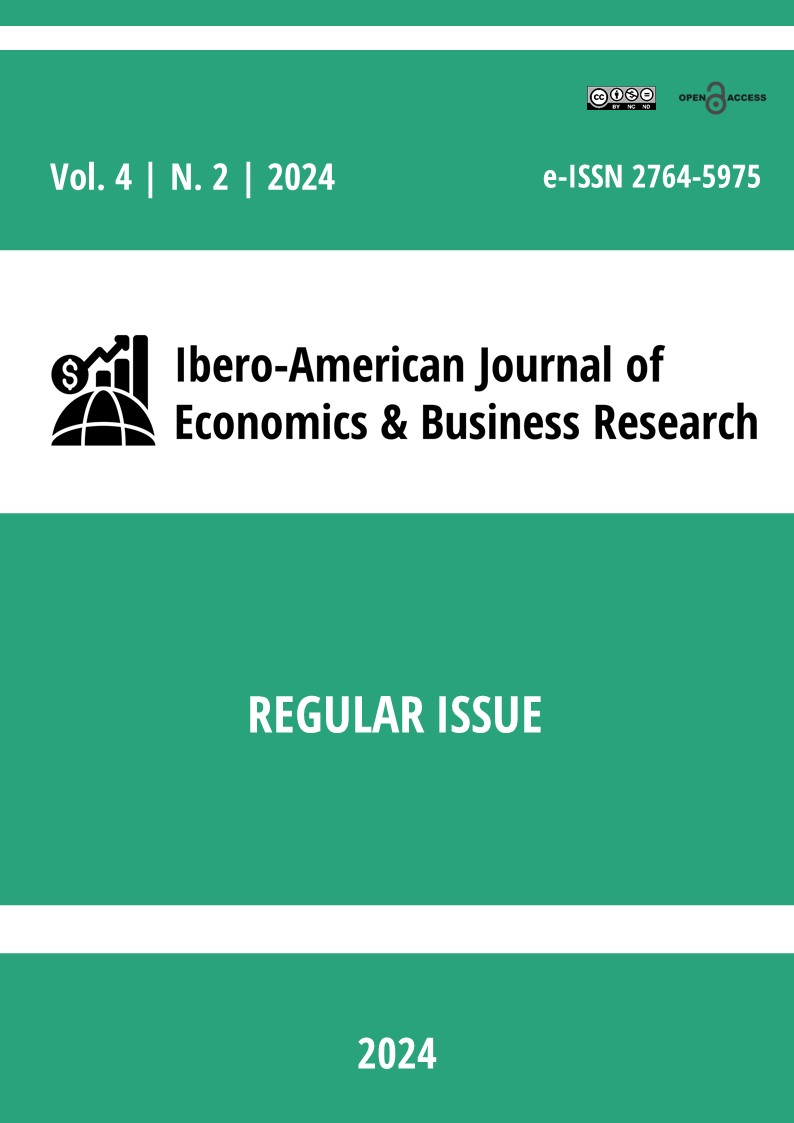The price of playing safe: uncovering the deep regret of conservative investors as risk-takers reap unmatched gains
DOI:
https://doi.org/10.56183/iberoecb.v4i2.30Keywords:
behavioral finance, conservative investment, regret aversion, loss aversion, FOMOAbstract
This paper looks at the emotional and monetary consequences of being conservative with investment as opposed to being liberal as seen in today’s investment world. For instance, the majority of conservative investors are sometimes induced by the principal aim of avoiding risks and probably feeling regret later on as they notice that risks takers investors gain more rewards. This paper focuses on exploring the mental biases that cause these approaches, key among them being regret aversion, loss aversion and the FOMO concept from the behavioral finance theory. By looking into the ways conservative investors operate the risk/reward ratio, this paper helps in gaining a better understanding of the investment decision process, offer insight Individual investors and those financial professionals who help their clients choose a strategy that take into account psychological satisfaction in addition to several financial aspects.
References
Adkisson, R. V. (2008). Nudge: Improving decisions about health, wealth and happiness. The Social Science Journal, 45(4), 700–701. https://doi.org/10.1016/j.soscij.2008.09.003
Bakar, S., & Yi, A. N. C. (2016). The impact of psychological factors on investors’ decision making in Malaysian stock market: A case of Klang valley and Pahang. Procedia Economics and Finance, 35, 319–328. https://doi.org/10.1016/S2212-5671(16)00040-X
Barber, B. M., & Odean, T. (2001). Boys will be boys: Gender, overconfidence, and common stock investment. The Quarterly Journal of Economics, 116(1), 261–292. https://doi.org/10.1162/003355301556400
Barberis, N., & Thaler, R. (2003). A survey of behavioral finance. Handbook of the Economics of Finance, 1, 1053–1128. https://doi.org/10.1016/s1574-0102(03)01027-6
Becker, G. S. (1976). The economic approach to human behavior. University Of Chicago Press.
CFI Team. (2015). Dotcom bubble. Corporate Finance Institute. https://corporatefinanceinstitute.com/resources/career-map/sell-side/capital-markets/dotcom-bubble/
Clarke, T. (2015). The dot-com crash of 2000-2002. Moneymorning.com. https://moneymorning.com/2015/06/12/the-dot-com-crash-of-2000-2002
Clarke, T. (2015). The dot-com crash of 2000-2002. Moneymorning.com. https://moneymorning.com/2015/06/12/the-dot-com-crash-of-2000-2002
Dimitriou, D., & Simos, T. (2013). Contagion channels of the USA subprime financial crisis: Evidence from USA, EMU, China and Japan equity markets. Journal of Financial Economic Policy, 5(1), 61-71.
Frydman, C., & Benmelech, E. (2020, April 29). The 1918 influenza did not kill the US economy. CEPR. https://cepr.org/voxeu/columns/1918-influenza-did-not-kill-us-economy
Gazel, S. (2015). The regret aversion as an investor bias. International Journal of Arts & Sciences, 4(2), 419–424. https://www.researchgate.net/publication/295833430_The_Regret_Aversion_As_An_Investor_Bias
Gigante, S. (2024, July). Investor profile: Are you conservative? MassMutual. https://blog.massmutual.com/retiring-investing/investor-profile-conservative
Gigerenzer, G. (2008). Gut feelings : The intelligence of the unconscious. Penguin Books.
Hayes, A. (2024, May 31). What ever happened to the dotcom bubble? Investopedia. https://www.investopedia.com/terms/d/dotcom-bubble.asp
Hayes, A. (2024). Conservative investing. Investopedia. https://www.investopedia.com/terms/c/conservativeinvesting.asp
Hicks, C. (2024, November 8). Retirement income strategies for the long haul. Kiplinger. https://www.kiplinger.com/retirement/retirement-income-strategies-for-the-long-haul
Irfan, M., Raima Adeel, & Muhammad Shaukat Malik. (2023). The Impact of Emotional Finance, and Market Knowledge and Investor Protection on Investment Performance in Stock and Real Estate Markets. SAGE Open, 13(4). https://doi.org/10.1177/21582440231206900
Kahneman, D., & Tversky, A. (1979). Prospect theory: An analysis of decision under risk. Econometrica, 47(2), 263–292. https://doi.org/10.2307/1914185
Krämer, W. (2013). Kahneman, D. (2011): Thinking, Fast and Slow. Statistical Papers, 55(3), 915–915. https://doi.org/10.1007/s00362-013-0533-y
Lee, L. X. (2021, February 18). Investors who try to time the market take on more risk and make less money: Study. UBC News. https://news.ubc.ca/2021/02/active-trading-leads-to-lower-returns/
Massachusetts Financial Services Company. (2024). The benefits of low volatility as a strategic allocation. https://www.mfs.com/en-us/investment-professional/insights/market-insights/the-benefits-of-low-volatility-as-a-strategic-allocation.html
Mayorga, P. (2024). The investment spectrum: Weighing the pros and cons of aggressive vs. conservative strategies. Apollo Capital Management. https://www.apollocapitalmanagement.com/blog/the-investment-spectrum-weighing-the-pros-and-cons-of-aggressive-vs-cons
Nationwide. (2024). Retirement Plans: Conservative Investments in Retirement . https://www.nationwide.com/personal/investing/retirement-plans/about-to-retire/conservative-portfolio/
Paudel, R., & Yedgarian, V. A. (2024). Nepal’s real estate landscape: Unveiling behavioral dynamics for strategic investments. Utsaha: Journal of Entrepreneurship, 3(2), 1–19. https://doi.org/10.56943/joe.v3i2.514
Peak Financial Planning. (2024). What is capital preservation? Hepeakfp.com. https://www.thepeakfp.com/blog/what-is-capital-preservation
Pilat, D. (2021). Why do we anticipate regret before we make a decision? Regret aversion. The Decision Lab. https://thedecisionlab.com/biases/regret-aversion
Rainier, G. (2022). What type of investor are you: The risk taker. Www.mandg.co.za. https://www.mandg.co.za/insights/articlesreleases/what-type-of-investor-are-you-the-risk-taker/
Rodriguez-Diaz, R. R., & Torres, C. A. R. (2022). Contagion effect of the Brazilian stock exchange in South America. Brazilian Journal of Business, 4(1), 444-458. https://doi.org/10.34140/bjbv4n1-026
Sanghvi, P. (2024). Prospect theory and its implications for investor behavior. FMP. https://site.financialmodelingprep.com/education/financial-analysis/Prospect-Theory-and-Its-Implications-for-Investor-Behavior
Shefrin, H., & Statman, M. (1985). The disposition to sell winners too early and ride losers too long: Theory and evidence. The Journal of Finance, 40(3), 777–790. https://doi.org/10.1111/j.1540-6261.1985.tb05002.x
Stalter, K., & McVearry, R. (2024). 7 high-return, low-risk investments for retirees. US News & World Report. https://money.usnews.com/investing/articles/high-return-low-risk-investments-for-retirees
Thaler, R. (1980). Toward a positive theory of consumer choice. Journal of Economic Behavior & Organization, 1(1), 39–60. https://doi.org/10.1016/0167-2681(80)90051-7
TPT Wealth. (2024). Conservative Investments. https://tptwealth.com.au/conservative-investments/
Tversky, A., & Kahneman, D. (1974). Judgment under uncertainty: Heuristics and biases. Science, 185(4157), 1124–1131. https://doi.org/10.1126/science.185.4157.1124
Tversky, A., & Kahneman, D. (1981). The framing of decisions and the psychology of choice. Science, 211(4481), 453–458. http://www.jstor.org/stable/1685855
Tversky, A., & Kahneman, D. (1991). Loss aversion in riskless choice: A reference dependent model. The Quarterly Journal of Economics, 106(4), 1039–1061. https://doi.org/10.2307/2937956
van Vliet, P. (2022). Conservative investing stands the test of time. The Investment Engineers. https://www.robeco.com/en-int/insights/2022/05/conservative-investing-stands-the-test-of-time
von Neumann, J., Morgenstern, O., & Rubinstein, A. (1944). Theory of games and economic behavior (60th anniversary commemorative edition). Princeton University Press; JSTOR. https://doi.org/10.2307/j.ctt1r2gkx
Wangzhou, K., Khan, M., Hussain, S., Ishfaq, M., & Farooqi, R. (2021). Effect of regret aversion and information cascade on investment decisions in the real estate sector: The mediating role of risk perception and the moderating effect of financial literacy. Frontiers in Psychology, 12. https://doi.org/10.3389/fpsyg.2021.736753
Yuvaraj D, & Venugopal, P. (2024). Examining the relationship between financial knowledge, risk tolerance, and past behavioural bias on investors actual investment behavior. RGSA, 18(6), e05739. https://doi.org/10.24857/rgsa.v18n6-025
Zhao , E., & Hall, C. R. (2025). The dot-com bubble: A historical perspective and a cautionary tale for the age of AI. IOSR Journal of Humanities and Social Science (IOSR-JHSS), 28(8), 04–07. https://doi.org/10.9790/0837-2808050407
Downloads
Published
How to Cite
Issue
Section
License
Copyright (c) 2024 Ram Paudel, Vahick A. Yedgarian

This work is licensed under a Creative Commons Attribution-NonCommercial-NoDerivatives 4.0 International License.



